ABSTRACT
This study was conducted to analyze the consumers’ perception of edible oil consumption in Myanmar. A total of 3,945 households from 15 regions/states of Myanmar were surveyed by agricultural officers of the Department of Agriculture in November 2021. Among the respondents, 75% perceived that the price of edible oil is expensive; however, 96% and 95% of respondents stated that they will not increase their edible oil consumption rate if the oil price is low and if their income is increased. Peanut oil has been preferred by 61.40% of the respondents followed by sesame oil and sunflower oil. With the top brands of peanut oil, palm oil and sesame oil in the market being locally manufactured with no brand names, unregistered and were not FDA certified, policy makers and regulatory bodies should continuously monitor and test for quality assurance and safety of these oils, increase public awareness and encourage Myanmar people to check for certification before buying the oils. Among the respondents, 72% stated that their consumption rate was moderate while 93% stated that they should reduce their consumption for health concerns. Despite this understanding, the per capita edible oil consumption rate was found to have increased nearly 64% over the last two decades in the previous study. Therefore, Myanmar people should be provided with public awareness and educational programs to encourage and incentivise them to optimize their oil consumption rate. These programs and interventions should increase public knowledge and share information concerning with oil consumption and how it can be harmful to human health if not consumed properly.
Keywords: Edible oils, Choice of brands, Oil types, Perceptions
INTRODUCTION
Edible oil consumption is one of the important factors in human diets as it can be harmful to health if not consumed properly. The study of the Department of Agricultural Economics of the Yezin Agricultural University (YAU) research team found that the annual edible oil consumption per capita of Myanmar was 14.39 kg which has increased by nearly 64% in the last two decades (May Thet Htar et al., 2022). This consumption growth rate alarms the policy makers to increase public health awareness related to oil consumption. Therefore, it becomes very important to analyze the consumers’ perceptions and attitudes towards brands, price, health and safety aspects of edible oil consumption. At the present state, in Myanmar, vegetable oil is the most consumed oil followed by peanut oil and mix oil as shown in Figure 1.
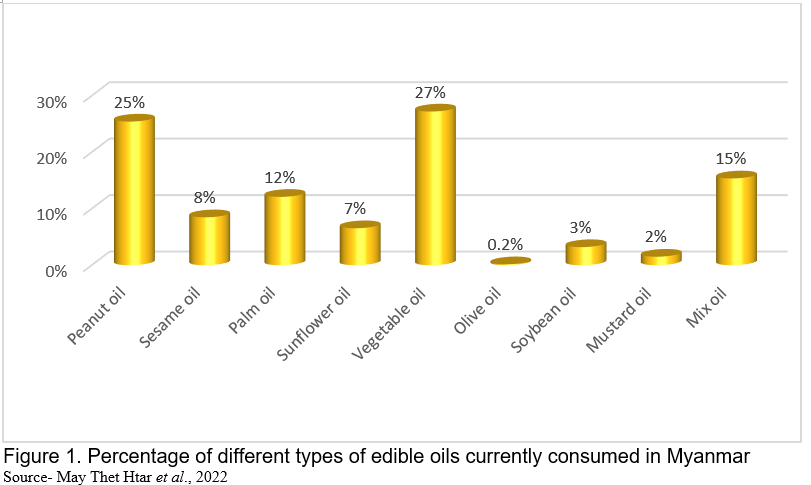
By acknowledging the consumer preferences of different brands, the specific brands that were dominating the market can be analyzed that will help point out the importance for policy makers and regulatory bodies to continuously monitor and test for quality assurance and safety of these brands. In addition, identifying consumers’ safety concerns and buying behaviors will help point out the need for public awareness programs to educate and encourage them to check for certifications and safety of their edible oils. Therefore, the main purpose of this study is to conduct a consumers’ preference and attitude survey in Myanmar to better understand the consumers’ perception and attitudes towards brands, price, health, and safety aspects of edible oil consumption. The following are the objectives of this study:
- To identify perception on the consumers’ health and safety perspectives of edible oil consumption; and
- To recognize the consumers’ preference toward types, brands and price of edible oil.
METHODOLOGY
Study sites for data collection
The Republic of the Union of Myanmar comprises of 15 states and regions namely, Kachin State, Kayah State, Kayin State, Chin State, Mon State, Rakhine State, Shan State, Tanintharyi Region, Ayeyarwady Region, Yangon Region, Bago Region, Mandalay Region, Magway Region, Sagaing Region and Naypyitaw Council Area. A total of 42 townships from these 15 states/regions were selected in this study.
Data collection and analysis
Data collection was undertaken in November 2021 through a structured questionnaire. The agricultural officers from the selected townships were appointed as enumerators for data collection. The trainings and instructions for data collection were provided by the research team from the Department of Agricultural Economics of the Yezin Agricultural University (YAU).
A total of 3,945 respondents were involved in this study and they came from different parts of the whole country from diverse populations which are comprised of different income levels, occupation types, and rural/urban residences. The potential respondents were based on the fact that they are the main household members managing food at the households to collect data on the amount of edible oil consumption and food expenses. The potential participants were self-selected in a voluntary way such that they were allowed to choose whether they want to participate or not. The enumerators visited the households, explained the purpose of the study, and solicited their voluntary participation. If the respondent agreed to be involved in the study, the interview was conducted using the structured questionnaire.
YAU research team collated and transmitted the data and conducted data cleansing. Analysis of the data, the interpretation and the writing were then carried out. Descriptive analyses (group-level) were used to generate the sample characteristics. Several ethical issues were considered throughout the study such as the respondents’ voluntary participation, questions posed to be non-personal in nature, confidentiality to be achieved by assigning a code to protect the respondents’ identity and the data to be accumulated to a group level.
RESULTS AND DISCUSSION
Monthly income of selected households
The monthly total incomes of the selected households are shown in Table 1. The average income of the household was US$170.32 per month. The highest monthly income was recorded to be US$1,810.81 while the lowest was US$16.22 per month. Half of the respondent households’ income ranged from US$100 to US$200. The households having the income lower than US$100 represent 24% of the total respondent households while 26% of the respondents have income higher than US$ 200.

Respondents’ perception on the price and consumption of edible oil
Over the entire sample population, 75% of the respondents perceived that the price of edible oil is expensive as shown in Figure 2. This large ratio of respondents who perceive that oil price is high which indicates that price is one of the most important factors in the oil market and oil consumption. Only 21% of them felt that the edible oil price is reasonable. Very few respondents, only 2% stated that edible oil price is low for them.
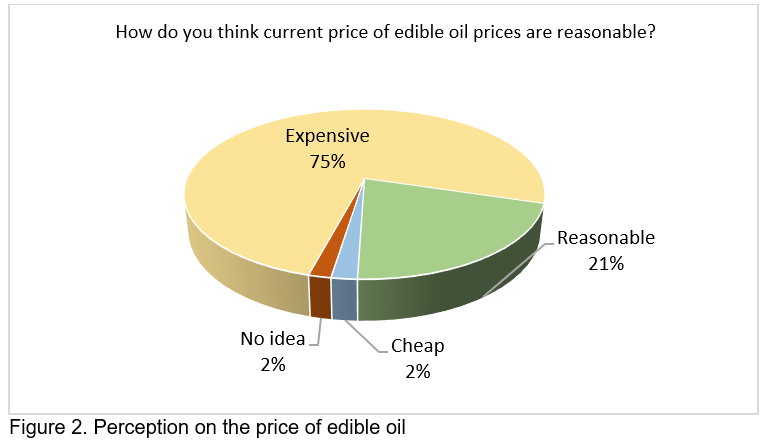
However, the edible oil consumption rate is independent of the price perception. As shown in Figure 3, when asked about the consumption if the price is low, 96% of respondents stated that they will not increase their edible oil consumption rate. Similarly, when asked about the consumption if their income is increased, 95% of the respondents stated that they will not increase their edible oil consumption rate. Therefore, it can be concluded that the edible oil consumption rate in the study areas is independent on the price and income changes even though price and income are important factors in the edible oil market and consumption generally. According to the health concern opinion of respondents, most of the households will not increase edible oil consumption whether the price decrease and income increase changes. However, significant influence upon switching from current oil type to higher-quality oil types still needs to be explored for further studies.

Most preferred edible oil types in Myanmar
As shown in Figure 4, the peanut oil is the most preferred edible oil in Myanmar as 61.40% of the respondents chose as their favorite oil type. However, the recent research of Department of Agricultural Economic, Yezin Agricultural University found out that vegetable oil is the top consumed oil in Myanmar (May Thet Htar et al., 2022). As peanut oil has been preferred by more than half of the surveyed respondents from different regions of Myanmar, the detail demand of peanut oil should further be analyzed. In addition, further research should analyze the reasons why vegetable oil is most-consumed oil while peanut oil is the most preferred oil type. For example, based on the findings stated in the above section, price may be one of the factors for choosing vegetable oil over peanut oil however, other factors such as availability in the market, certification, health, and taste factors or more may also contribute.
Sesame oil is the second most preferred oil type in Myanmar by 16.18% of the respondents while local sunflower oil is the third most preferred oil type by 6.72 % of the respondents. For imported sunflower oil, only 1.88 % of the respondents chose as their preference. Interestingly, although in the previous research of the Department of Agricultural Economics of the Yezin Agricultural University (YAU) research team, vegetable oil is the top-most consumed oil with 27% of people in Myanmar are consuming, it has been preferred only by 6.24% of the respondents in this research. As shown in Figure 4, 3.53% of the respondents prefer soybean oil, 2.43% of the respondents prefer mustard oil. Mix oil is the oil that is composed of 50% palm oil and 50% peanut or sesame oil. In this research, only 0.99% of the respondents prefer palm oil and only 0.33% of the respondents prefer mix oil (Figure 4). In the previous research, the former has been consumed by 12% and the latter by 15% of Myanmar people (May Thet Htar et al., 2022). Therefore, further research should be conducted to identify why these top-most consumed vegetable oils, highly consumed palm oil and mix oil have not been widely preferred by the consumers.
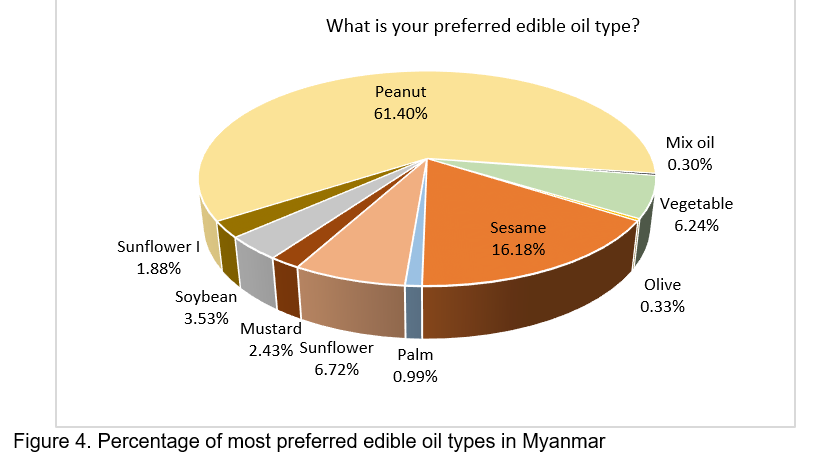
Top three household brands of different oil types
The top household brands of different oil types are shown in Table 2. This will indicate the brands that are dominating the market of particular oil type. In the case of peanut oil and sesame oil which are the two top preferred oil types by 77% of Myanmar people, the most consumed brands of these oils are locally made brands which are unlabelled and unregistered. This seriously alarms the importance of the investigation for the quality and health aspects of these locally produced oils as these oil brands occupy 11.73% and 8.33% in their respective markets. Therefore, the health experts and policy makers should properly monitor these brands and the way they were manufactured to ensure the nutritional contents and safety of public health.
In terms of vegetable oil, Chue Htet Hnin et al., (2021) stated that all vegetable oils in the market are imported. The top three popular brands are “Two Prawns”, “Goody”, and “Meizan”. These three brands occupy 74.12% of the vegetable oil markets. Therefore, the quality and safety of these imported vegetable oil brands should also need to be properly monitored.
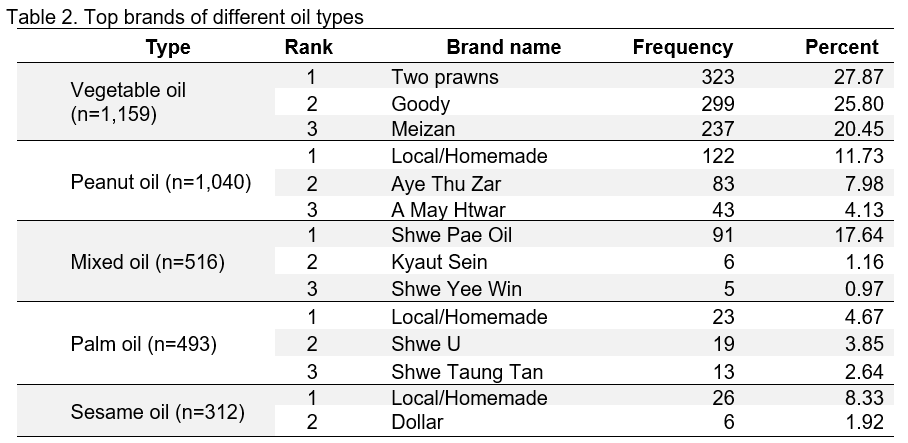
Perception on the rate of edible oil consumption and health fitness
When asked about their perceptions on their household edible oil consumption rate, more than half, 72% of the respondents stated that their consumption rate was moderate. The rest or 15% of the respondents felt that they consumed high amount of edible oil while 10% of them stated that their edible oil consumption rate is low (Figure 5). As shown in Figure 6 in the next section, 93% of the respondents stated that they agree that they should reduce edible oil consumption for health concerns. However, the per capita edible oil consumption rate has increased nearly by 64% in the last two decades as discussed above. Therefore, the 82% of people who did not perceive that their consumption is high should be provided with public awareness programs to encourage and incentivise them to reduce the rate of their oil consumption.
As shown in Figure 6, when asked about their perception on edible oil consumption rate in relation to health and fitness, about half of the respondents, 54% felt that their consumption rate is suitable to health. Among the respondents, 33% of them stated that their edible oil consumption is not quite suitable to health while 13% of them stated that they do not know if their consumption is fit to health or not. Therefore, programs and interventions should be conducted to increase public knowledge and share information concerning about oil consumption and how it can be harmful to human health if not consumed properly.

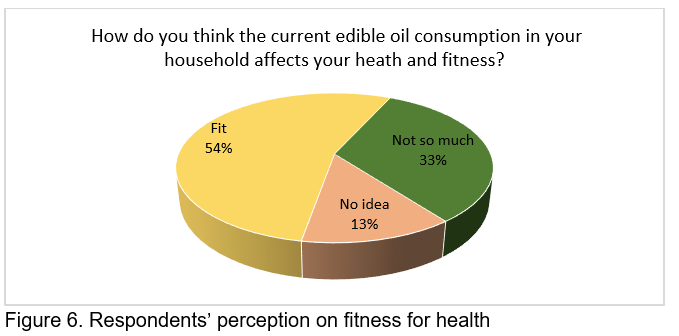
Perception on the safety of edible oils
Regarding reusing the cooking oil, 76% of the respondents felt that it is not safe to reuse the cooking oil while 24% felt it is safe enough (Figure 7). Most of the respondents, (96%) stated that they do not think reusing cooking oil is good for human health. Importantly, 4% of the respondents still thought reusing cooking oil is good for health.
Regarding nutritional information and certifications, 85% of the respondents stated that they never check the information and certifications before purchasing the oils (Figure 8). Similarly, the same ratio of respondents did not check whether the edible oil they are consuming is FDA certified or not. This finding is promising given that the top brands of peanut oil, palm oil and sesame oil in the market are locally manufactured with no brand names, unregistered and are not FDA certified as shown in Table 2. Therefore, this information pointed out the importance of policy makers and regulatory bodies to monitor and inspect for quality assurance and safety of these locally manufactured, uncertified edible oils and to increase public awareness to check for certification before buying the oils.
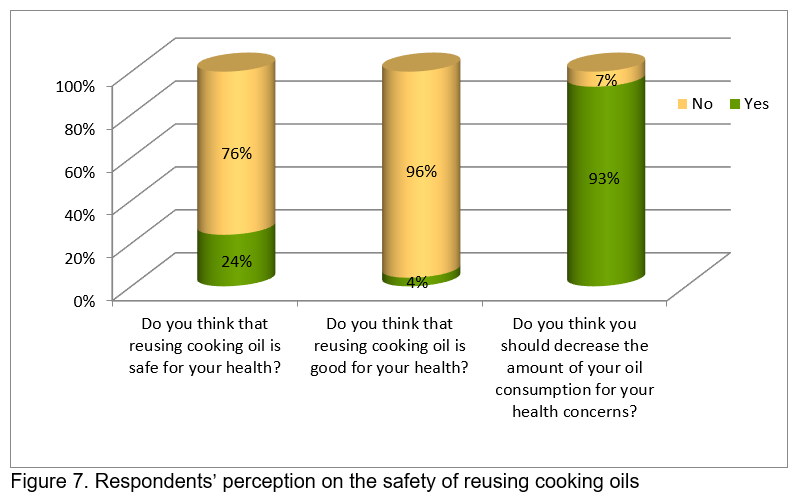

CONCLUSION AND RECOMMENDATION
This study was conducted from a total of 3,945 households from 15 regions/states of Myanmar. The average income of the surveyed household was US$170.32 per month ranging from US$16.22 to US$1,810.81. Over the entire sample population, 75% of the respondents perceived that the price of edible oil is expensive. When asked about the consumption changes, 96% and 95% of respondents stated that they will not increase their edible oil consumption rate even if the oil price is low and if the income is increased. Therefore, it can be concluded that the edible oil consumption rate is independent on the price and income changes. However, the question whether these price and income changes have any influence upon switching from the current oil type to higher-quality oil types still needs to be explored.
As peanut oil has been preferred by more than half of the surveyed respondents, 61.40% from different regions of Myanmar, the detail demand of peanut oil should further be analyzed. In addition, further research should analyze the reasons why the vegetable oil is most consumed oil while peanut oil is the most preferred oil type. For example, based on the findings stated, price may be one of the factors. Sesame oil is the second most preferred oil type followed by local sunflower oil. Further research should be conducted to identify why these top-most consumed vegetable oil, highly consumed palm oil and mix oil have not been widely preferred by the consumers.
The most consumed brands of peanut oil, palm oil and sesame oil are locally made brands which are unlabelled and uncertified. This seriously alarms the importance of the investigation for the quality and health aspects of these locally produced oils. The health experts and policy makers should properly monitor these brands and the way they were manufactured to ensure the nutritional contents and safety for public health. All vegetables oils are imported, and the top three popular brands are “Two Prawns”, “Goody”, and “Meizan” which occupy 74% of the vegetable oil markets. Therefore, the quality and safety of these imported vegetable oil brands should also need to be properly monitored.
When asked about their perceptions on their household edible oil consumption rate, more than half, 72% of the respondents stated that their consumption rate was moderate while 93% of the respondents stated that they agree that they should reduce edible oil consumption for health concerns. However, despite their understanding to reduce oil consumption for health concerns, recent research stated that the per capita edible oil consumption rate has increased by nearly 64% in the last two decades. Therefore, the Myanmar people should be provided with public awareness programs to encourage and incentivise them to optimize their oil consumption rate. These programs and interventions should increase public knowledge and share information concerning oil consumption and how it can be harmful to health if not consumed properly.
Regarding the reusing of cooking oil, 76% of the respondents felt that it is not safe to reuse the cooking oil; similarly, 96% of them stated that they do not think reusing cooking oil is good for human health. When purchasing the oils, 85% of the respondents stated that they never check the nutritional information and FDA certification. With the top brands of peanut oil, palm oil and sesame oil in the market being locally manufactured with no brand names, unregistered and not FDA certified, policy makers and regulatory bodies should do monitoring and inspection for quality assurance and safety of these locally manufactured oils. There should also be an increase in public awareness and the Myanmar people should be encouraged to stop reusing cooking oils and check for their certification before buying the edible oils.
REFERENCES
Chue Htet Hnin, Theingi Myint, Thi Thi Soe, Moh Moh, Cho Zin Win (2021) “Edible oil in the Market, Nay Pyi Taw, Myanmar: Types, Brands, Market Prices and Consumer Preferences”, FFTC Agricultural Policy Platform,https://ap.fftc.org.tw/article/2928
May Thet Htar, Theingi Myint, Thi Thi Soe, Moh Moh, Yin Nyein Aye, Chue Htet Hnin, Htet Marlar Aye (2022) “Analysis of edible oil consumption in Myanmar; per capita consumption, oil types and regional differences” FFTC Agricultural Policy Platform, Publication in progress.


Analysis of Edible Oil Consumption in Myanmar: Consumers’ Perception towards Brands, Price, and Health Aspects
ABSTRACT
This study was conducted to analyze the consumers’ perception of edible oil consumption in Myanmar. A total of 3,945 households from 15 regions/states of Myanmar were surveyed by agricultural officers of the Department of Agriculture in November 2021. Among the respondents, 75% perceived that the price of edible oil is expensive; however, 96% and 95% of respondents stated that they will not increase their edible oil consumption rate if the oil price is low and if their income is increased. Peanut oil has been preferred by 61.40% of the respondents followed by sesame oil and sunflower oil. With the top brands of peanut oil, palm oil and sesame oil in the market being locally manufactured with no brand names, unregistered and were not FDA certified, policy makers and regulatory bodies should continuously monitor and test for quality assurance and safety of these oils, increase public awareness and encourage Myanmar people to check for certification before buying the oils. Among the respondents, 72% stated that their consumption rate was moderate while 93% stated that they should reduce their consumption for health concerns. Despite this understanding, the per capita edible oil consumption rate was found to have increased nearly 64% over the last two decades in the previous study. Therefore, Myanmar people should be provided with public awareness and educational programs to encourage and incentivise them to optimize their oil consumption rate. These programs and interventions should increase public knowledge and share information concerning with oil consumption and how it can be harmful to human health if not consumed properly.
Keywords: Edible oils, Choice of brands, Oil types, Perceptions
INTRODUCTION
Edible oil consumption is one of the important factors in human diets as it can be harmful to health if not consumed properly. The study of the Department of Agricultural Economics of the Yezin Agricultural University (YAU) research team found that the annual edible oil consumption per capita of Myanmar was 14.39 kg which has increased by nearly 64% in the last two decades (May Thet Htar et al., 2022). This consumption growth rate alarms the policy makers to increase public health awareness related to oil consumption. Therefore, it becomes very important to analyze the consumers’ perceptions and attitudes towards brands, price, health and safety aspects of edible oil consumption. At the present state, in Myanmar, vegetable oil is the most consumed oil followed by peanut oil and mix oil as shown in Figure 1.
By acknowledging the consumer preferences of different brands, the specific brands that were dominating the market can be analyzed that will help point out the importance for policy makers and regulatory bodies to continuously monitor and test for quality assurance and safety of these brands. In addition, identifying consumers’ safety concerns and buying behaviors will help point out the need for public awareness programs to educate and encourage them to check for certifications and safety of their edible oils. Therefore, the main purpose of this study is to conduct a consumers’ preference and attitude survey in Myanmar to better understand the consumers’ perception and attitudes towards brands, price, health, and safety aspects of edible oil consumption. The following are the objectives of this study:
METHODOLOGY
Study sites for data collection
The Republic of the Union of Myanmar comprises of 15 states and regions namely, Kachin State, Kayah State, Kayin State, Chin State, Mon State, Rakhine State, Shan State, Tanintharyi Region, Ayeyarwady Region, Yangon Region, Bago Region, Mandalay Region, Magway Region, Sagaing Region and Naypyitaw Council Area. A total of 42 townships from these 15 states/regions were selected in this study.
Data collection and analysis
Data collection was undertaken in November 2021 through a structured questionnaire. The agricultural officers from the selected townships were appointed as enumerators for data collection. The trainings and instructions for data collection were provided by the research team from the Department of Agricultural Economics of the Yezin Agricultural University (YAU).
A total of 3,945 respondents were involved in this study and they came from different parts of the whole country from diverse populations which are comprised of different income levels, occupation types, and rural/urban residences. The potential respondents were based on the fact that they are the main household members managing food at the households to collect data on the amount of edible oil consumption and food expenses. The potential participants were self-selected in a voluntary way such that they were allowed to choose whether they want to participate or not. The enumerators visited the households, explained the purpose of the study, and solicited their voluntary participation. If the respondent agreed to be involved in the study, the interview was conducted using the structured questionnaire.
YAU research team collated and transmitted the data and conducted data cleansing. Analysis of the data, the interpretation and the writing were then carried out. Descriptive analyses (group-level) were used to generate the sample characteristics. Several ethical issues were considered throughout the study such as the respondents’ voluntary participation, questions posed to be non-personal in nature, confidentiality to be achieved by assigning a code to protect the respondents’ identity and the data to be accumulated to a group level.
RESULTS AND DISCUSSION
Monthly income of selected households
The monthly total incomes of the selected households are shown in Table 1. The average income of the household was US$170.32 per month. The highest monthly income was recorded to be US$1,810.81 while the lowest was US$16.22 per month. Half of the respondent households’ income ranged from US$100 to US$200. The households having the income lower than US$100 represent 24% of the total respondent households while 26% of the respondents have income higher than US$ 200.
Respondents’ perception on the price and consumption of edible oil
Over the entire sample population, 75% of the respondents perceived that the price of edible oil is expensive as shown in Figure 2. This large ratio of respondents who perceive that oil price is high which indicates that price is one of the most important factors in the oil market and oil consumption. Only 21% of them felt that the edible oil price is reasonable. Very few respondents, only 2% stated that edible oil price is low for them.
However, the edible oil consumption rate is independent of the price perception. As shown in Figure 3, when asked about the consumption if the price is low, 96% of respondents stated that they will not increase their edible oil consumption rate. Similarly, when asked about the consumption if their income is increased, 95% of the respondents stated that they will not increase their edible oil consumption rate. Therefore, it can be concluded that the edible oil consumption rate in the study areas is independent on the price and income changes even though price and income are important factors in the edible oil market and consumption generally. According to the health concern opinion of respondents, most of the households will not increase edible oil consumption whether the price decrease and income increase changes. However, significant influence upon switching from current oil type to higher-quality oil types still needs to be explored for further studies.
Most preferred edible oil types in Myanmar
As shown in Figure 4, the peanut oil is the most preferred edible oil in Myanmar as 61.40% of the respondents chose as their favorite oil type. However, the recent research of Department of Agricultural Economic, Yezin Agricultural University found out that vegetable oil is the top consumed oil in Myanmar (May Thet Htar et al., 2022). As peanut oil has been preferred by more than half of the surveyed respondents from different regions of Myanmar, the detail demand of peanut oil should further be analyzed. In addition, further research should analyze the reasons why vegetable oil is most-consumed oil while peanut oil is the most preferred oil type. For example, based on the findings stated in the above section, price may be one of the factors for choosing vegetable oil over peanut oil however, other factors such as availability in the market, certification, health, and taste factors or more may also contribute.
Sesame oil is the second most preferred oil type in Myanmar by 16.18% of the respondents while local sunflower oil is the third most preferred oil type by 6.72 % of the respondents. For imported sunflower oil, only 1.88 % of the respondents chose as their preference. Interestingly, although in the previous research of the Department of Agricultural Economics of the Yezin Agricultural University (YAU) research team, vegetable oil is the top-most consumed oil with 27% of people in Myanmar are consuming, it has been preferred only by 6.24% of the respondents in this research. As shown in Figure 4, 3.53% of the respondents prefer soybean oil, 2.43% of the respondents prefer mustard oil. Mix oil is the oil that is composed of 50% palm oil and 50% peanut or sesame oil. In this research, only 0.99% of the respondents prefer palm oil and only 0.33% of the respondents prefer mix oil (Figure 4). In the previous research, the former has been consumed by 12% and the latter by 15% of Myanmar people (May Thet Htar et al., 2022). Therefore, further research should be conducted to identify why these top-most consumed vegetable oils, highly consumed palm oil and mix oil have not been widely preferred by the consumers.
Top three household brands of different oil types
The top household brands of different oil types are shown in Table 2. This will indicate the brands that are dominating the market of particular oil type. In the case of peanut oil and sesame oil which are the two top preferred oil types by 77% of Myanmar people, the most consumed brands of these oils are locally made brands which are unlabelled and unregistered. This seriously alarms the importance of the investigation for the quality and health aspects of these locally produced oils as these oil brands occupy 11.73% and 8.33% in their respective markets. Therefore, the health experts and policy makers should properly monitor these brands and the way they were manufactured to ensure the nutritional contents and safety of public health.
In terms of vegetable oil, Chue Htet Hnin et al., (2021) stated that all vegetable oils in the market are imported. The top three popular brands are “Two Prawns”, “Goody”, and “Meizan”. These three brands occupy 74.12% of the vegetable oil markets. Therefore, the quality and safety of these imported vegetable oil brands should also need to be properly monitored.
Perception on the rate of edible oil consumption and health fitness
When asked about their perceptions on their household edible oil consumption rate, more than half, 72% of the respondents stated that their consumption rate was moderate. The rest or 15% of the respondents felt that they consumed high amount of edible oil while 10% of them stated that their edible oil consumption rate is low (Figure 5). As shown in Figure 6 in the next section, 93% of the respondents stated that they agree that they should reduce edible oil consumption for health concerns. However, the per capita edible oil consumption rate has increased nearly by 64% in the last two decades as discussed above. Therefore, the 82% of people who did not perceive that their consumption is high should be provided with public awareness programs to encourage and incentivise them to reduce the rate of their oil consumption.
As shown in Figure 6, when asked about their perception on edible oil consumption rate in relation to health and fitness, about half of the respondents, 54% felt that their consumption rate is suitable to health. Among the respondents, 33% of them stated that their edible oil consumption is not quite suitable to health while 13% of them stated that they do not know if their consumption is fit to health or not. Therefore, programs and interventions should be conducted to increase public knowledge and share information concerning about oil consumption and how it can be harmful to human health if not consumed properly.
Perception on the safety of edible oils
Regarding reusing the cooking oil, 76% of the respondents felt that it is not safe to reuse the cooking oil while 24% felt it is safe enough (Figure 7). Most of the respondents, (96%) stated that they do not think reusing cooking oil is good for human health. Importantly, 4% of the respondents still thought reusing cooking oil is good for health.
Regarding nutritional information and certifications, 85% of the respondents stated that they never check the information and certifications before purchasing the oils (Figure 8). Similarly, the same ratio of respondents did not check whether the edible oil they are consuming is FDA certified or not. This finding is promising given that the top brands of peanut oil, palm oil and sesame oil in the market are locally manufactured with no brand names, unregistered and are not FDA certified as shown in Table 2. Therefore, this information pointed out the importance of policy makers and regulatory bodies to monitor and inspect for quality assurance and safety of these locally manufactured, uncertified edible oils and to increase public awareness to check for certification before buying the oils.
CONCLUSION AND RECOMMENDATION
This study was conducted from a total of 3,945 households from 15 regions/states of Myanmar. The average income of the surveyed household was US$170.32 per month ranging from US$16.22 to US$1,810.81. Over the entire sample population, 75% of the respondents perceived that the price of edible oil is expensive. When asked about the consumption changes, 96% and 95% of respondents stated that they will not increase their edible oil consumption rate even if the oil price is low and if the income is increased. Therefore, it can be concluded that the edible oil consumption rate is independent on the price and income changes. However, the question whether these price and income changes have any influence upon switching from the current oil type to higher-quality oil types still needs to be explored.
As peanut oil has been preferred by more than half of the surveyed respondents, 61.40% from different regions of Myanmar, the detail demand of peanut oil should further be analyzed. In addition, further research should analyze the reasons why the vegetable oil is most consumed oil while peanut oil is the most preferred oil type. For example, based on the findings stated, price may be one of the factors. Sesame oil is the second most preferred oil type followed by local sunflower oil. Further research should be conducted to identify why these top-most consumed vegetable oil, highly consumed palm oil and mix oil have not been widely preferred by the consumers.
The most consumed brands of peanut oil, palm oil and sesame oil are locally made brands which are unlabelled and uncertified. This seriously alarms the importance of the investigation for the quality and health aspects of these locally produced oils. The health experts and policy makers should properly monitor these brands and the way they were manufactured to ensure the nutritional contents and safety for public health. All vegetables oils are imported, and the top three popular brands are “Two Prawns”, “Goody”, and “Meizan” which occupy 74% of the vegetable oil markets. Therefore, the quality and safety of these imported vegetable oil brands should also need to be properly monitored.
When asked about their perceptions on their household edible oil consumption rate, more than half, 72% of the respondents stated that their consumption rate was moderate while 93% of the respondents stated that they agree that they should reduce edible oil consumption for health concerns. However, despite their understanding to reduce oil consumption for health concerns, recent research stated that the per capita edible oil consumption rate has increased by nearly 64% in the last two decades. Therefore, the Myanmar people should be provided with public awareness programs to encourage and incentivise them to optimize their oil consumption rate. These programs and interventions should increase public knowledge and share information concerning oil consumption and how it can be harmful to health if not consumed properly.
Regarding the reusing of cooking oil, 76% of the respondents felt that it is not safe to reuse the cooking oil; similarly, 96% of them stated that they do not think reusing cooking oil is good for human health. When purchasing the oils, 85% of the respondents stated that they never check the nutritional information and FDA certification. With the top brands of peanut oil, palm oil and sesame oil in the market being locally manufactured with no brand names, unregistered and not FDA certified, policy makers and regulatory bodies should do monitoring and inspection for quality assurance and safety of these locally manufactured oils. There should also be an increase in public awareness and the Myanmar people should be encouraged to stop reusing cooking oils and check for their certification before buying the edible oils.
REFERENCES
Chue Htet Hnin, Theingi Myint, Thi Thi Soe, Moh Moh, Cho Zin Win (2021) “Edible oil in the Market, Nay Pyi Taw, Myanmar: Types, Brands, Market Prices and Consumer Preferences”, FFTC Agricultural Policy Platform,https://ap.fftc.org.tw/article/2928
May Thet Htar, Theingi Myint, Thi Thi Soe, Moh Moh, Yin Nyein Aye, Chue Htet Hnin, Htet Marlar Aye (2022) “Analysis of edible oil consumption in Myanmar; per capita consumption, oil types and regional differences” FFTC Agricultural Policy Platform, Publication in progress.